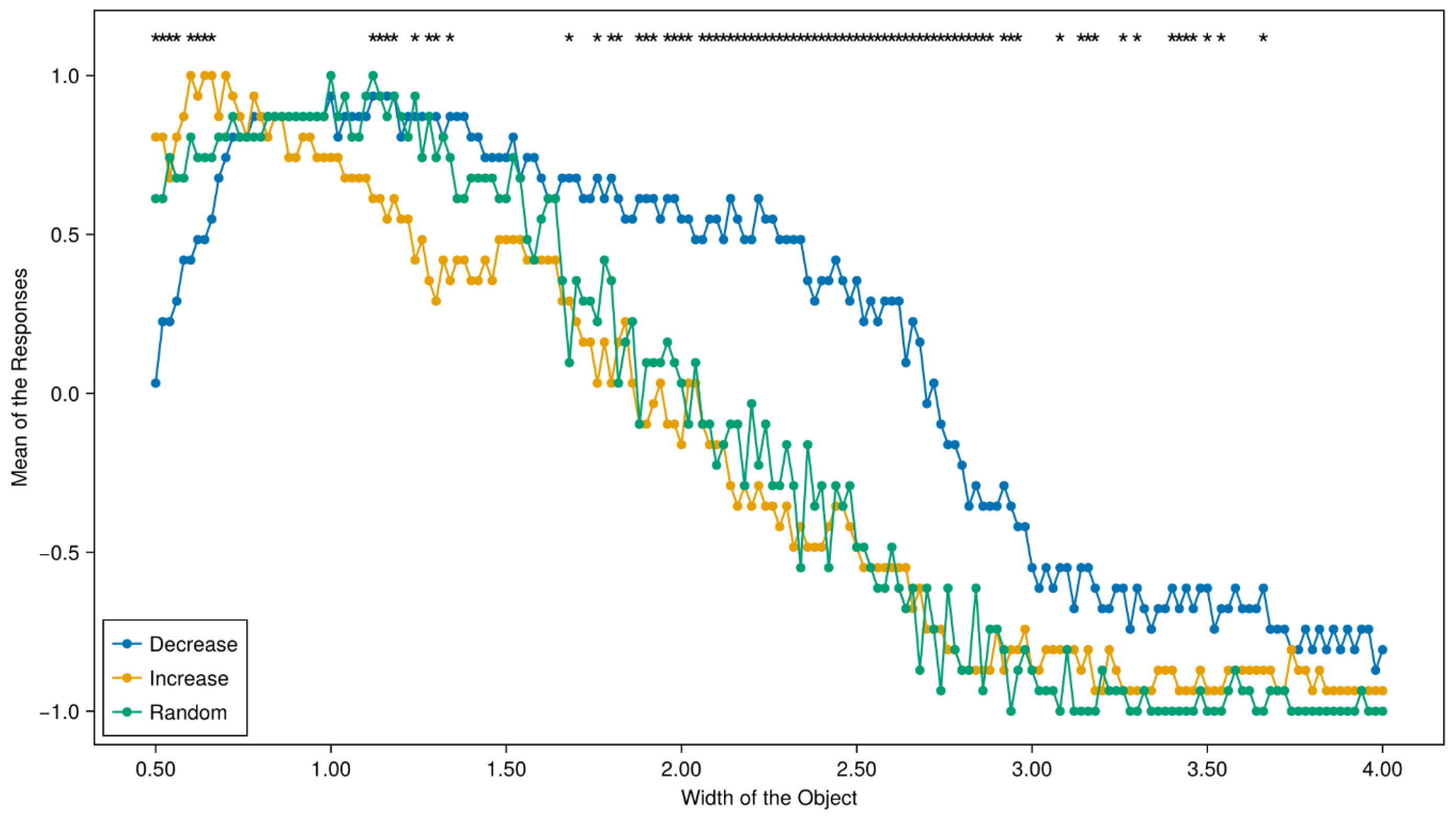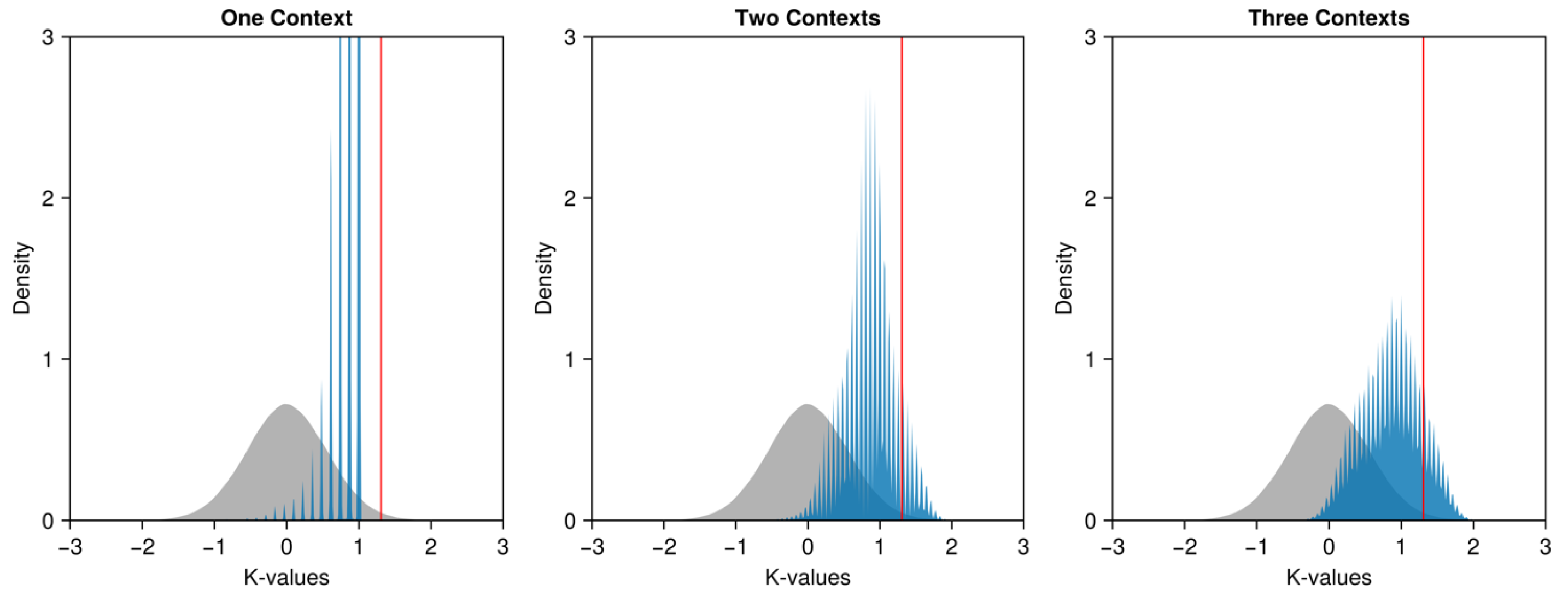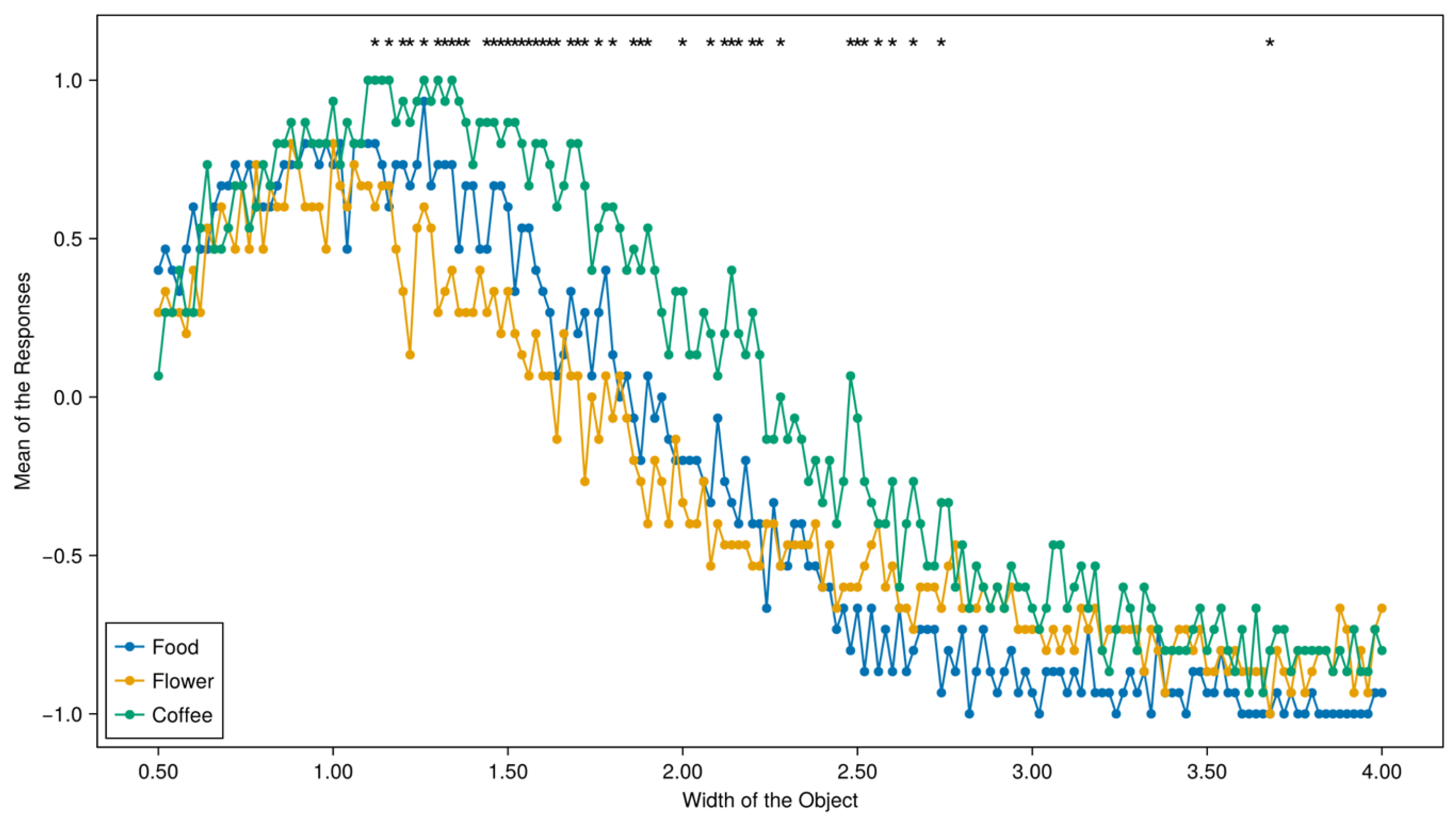Violation of Leggett–Garg Inequality in Perceiving Cup-like Objects and Cognitive Contextuality
Abstract
1. Introduction
2. Contextuality and Cyclic Systems with Different Ranks
3. General Method
3.1. Test Stimuli
3.2. Physical and Social Contexts
3.3. Experimental Procedure
3.4. Data Analyses
4. Experiment 1
4.1. Participants
4.2. Results
5. Experiment 2
5.1. Participants
5.2. Results
6. Discussion on Connection with Cognitive Hysteresis
7. Concluding Remarks
Author Contributions
Funding
Data Availability Statement
Acknowledgments
Conflicts of Interest
Appendix A. Proof of Equation (3)
References
- Anderson, J.R. The Architecture of Cognition; Lawrence Erlbaum Associates, Inc.: Hillsdale, NJ, USA, 1983; p. 345. [Google Scholar]
- Rysiew, P. The Context-Sensitivity of Knowledge Attributions. Noûs 2002, 35, 477–514. [Google Scholar] [CrossRef]
- Arminen, I. On the Context Sensitivity of Institutional Interaction. Discourse Soc. 2016, 11, 435–458. [Google Scholar] [CrossRef]
- Coifman, K.G.; Bonanno, G.A. Emotion context sensitivity in adaptation and recovery. In Emotion Regulation and Psychopathology: A Transdiagnostic Approach to Etiology and Treatment; The Guilford Press: New York, NY, USA, 2010; pp. 157–173. [Google Scholar]
- Pliskin, R.; Ruhrman, A.; Halperin, E. Proposing a multi-dimensional, context-sensitive approach to the study of ideological (a)symmetry in emotion. Curr. Opin. Behav. Sci. 2020, 34, 75–80. [Google Scholar] [CrossRef]
- Aerts, D.; Broekaert, J.; Gabora, L. Intrinsic Contextuality as the Crux of Consciousness; Yasue, K., Ed.; John Benjamins Publishing Company: Philadelphia, PA, USA, 2000. [Google Scholar]
- Khrennikov, A.Y. Ubiquitous Quantum Structure: From Psychology to Finance; Springer: Berlin/Heidelberg, Germany, 2010. [Google Scholar]
- Bruza, P.D.; Kitto, K.; Ramm, B.J.; Sitbon, L. A probabilistic framework for analysing the compositionality of conceptual combinations. J. Math. Psychol. 2015, 67, 26–38. [Google Scholar] [CrossRef]
- de Barros, J.A.; Kujala, J.V.; Oas, G. Negative probabilities and contextuality. J. Math. Psychol. 2016, 74, 34–45. [Google Scholar] [CrossRef]
- Plotnitsky, A.; Haven, E. (Eds.) The Quantum-Like Revolution: A Festschrift for Andrei Khrennikov; Springer: Berlin/Heidelberg, Germany, 2023. [Google Scholar]
- Bruza, P.D.; Fell, L.; Hoyte, P.; Dehdashti, S.; Obeid, A.; Gibson, A.; Moreira, C. Contextuality and context-sensitivity in probabilistic models of cognition. Cogn. Psychol. 2023, 140, 101529. [Google Scholar] [CrossRef]
- Busemeyer, J.R.; Bruza, P.D. Quantum Models of Cognition and Decision; Cambridge University Press: Cambridge, UK, 2012. [Google Scholar]
- Haven, E.; Khrennikov, A. Quantum Social Science; Cambridge University Press: Cambridge, UK, 2013. [Google Scholar]
- Asano, M.; Hashimoto, T.; Khrennikov, A.; Ohya, M.; Tanaka, Y. Violation of contextual generalization of the Leggett–Garg inequality for recognition of ambiguous figures. Phys. Scr. 2014, T163, 014006. [Google Scholar] [CrossRef]
- Bagarello, F. Quantum Concepts in the Social, Ecological and Biological Sciences; Cambridge University Press: Cambridge, UK, 2019. [Google Scholar] [CrossRef]
- Hameroff, S.R. Quantum coherence in microtubules: A neural basis for emergent consciousness? J. Conscious. Stud. 1994, 1, 91–118. [Google Scholar]
- Penrose, R. The Emperor’s New Mind: Concerning Computers, Minds, and the Laws of Physics; Oxford University Press: New York, NY, US, 1989; p. 466. [Google Scholar]
- Khrennikov, A. Quantum-like brain: “Interference of minds”. Biosystems 2006, 84, 225–241. [Google Scholar] [CrossRef]
- Tsuchiya, N.; Bruza, P.; Yamada, M.; Saigo, H.; Pothos, E.M. Quantum-like qualia hypothesis: From quantum cognition to quantum perception. Front. Psychol. 2024, 15, 1406459. [Google Scholar]
- Kahneman, D. Thinking Fast and Slow; Famar, Straus and Giroux: New York, NY, USA, 2011. [Google Scholar]
- Ozawa, M.; Khrennikov, A. Nondistributivity of human logic and violation of response replicability effect in cognitive psychology. J. Math. Psychol. 2023, 112, 102739. [Google Scholar] [CrossRef]
- Wang, Z.; Busemeyer, J.R. A quantum question order model supported by empirical tests of an a priori and precise prediction. Top. Cogn. Sci. 2013, 5, 689–710. [Google Scholar] [CrossRef]
- Pothos, E.M.; Busemeyer, J.R. Quantum Cognition. Annu. Rev. Psychol. 2021, 73, 749–778. [Google Scholar] [CrossRef]
- Khrennikov, A. Open systems, quantum probability, and logic for quantum-like modeling in biology, cognition, and decision-making. Entropy 2023, 25, 886. [Google Scholar] [CrossRef]
- Svozil, K. Varieties of contextuality based on probability and structural nonembeddability. Theor. Comput. Sci. 2022, 924, 117–128. [Google Scholar] [CrossRef]
- Bell, J.S. Speakable and Unspeakable in Quantum Mechanics: Collected Papers on Quantum Philosophy, 2nd ed.; Cambridge University Press: Cambridge, UK, 2004. [Google Scholar] [CrossRef]
- Conte, E.; Khrennikov, A.Y.; Todarello, O.; De Robertis, R.; Federici, A.; Zbilut, J.P. A Preliminary Experimental Verification On the Possibility of Bell Inequality Violation in Mental States. Neuroquantology 2008, 6, 214–221. [Google Scholar] [CrossRef]
- Cervantes, V.H.; Dzhafarov, E.N. Snow queen is evil and beautiful: Experimental evidence for probabilistic contextuality in human choices. Decision 2018, 5, 193–204. [Google Scholar] [CrossRef]
- Basieva, I.; Cervantes, V.H.; Dzhafarov, E.N.; Khrennikov, A. True contextuality beats direct influences in human decision making. J. Exp. Psychol. Gen. 2019, 148, 1925–1937. [Google Scholar] [CrossRef]
- Gallus, C.; Pothos, E.M.; Blasiak, P.; Yearsley, J.M.; Wojciechowski, B.W. Bell correlations outside physics. Sci. Rep. 2023, 13, 4394. [Google Scholar] [CrossRef]
- De Barros, J.; Holik, F.; Krause, D. Contextuality and Indistinguishability. Entropy 2017, 19, 435. [Google Scholar] [CrossRef]
- Leggett, A.J.; Garg, A. Quantum mechanics versus macroscopic realism: Is the flux there when nobody looks? Phys. Rev. Lett. 1985, 54, 857–860. [Google Scholar] [CrossRef] [PubMed]
- Araújo, M.; Quintino, M.T.; Budroni, C.; Cunha, M.T.; Cabello, A. All noncontextuality inequalities for the n-cycle scenario. Phys. Rev. A 2013, 88, 022118. [Google Scholar] [CrossRef]
- Dzhafarov, E.N.; Kujala, J.V. Context–content systems of random variables: The contextuality-by-default theory. J. Math. Psychol. 2016, 74, 11–33. [Google Scholar] [CrossRef]
- Klyachko, A.A.; Can, M.A.; Binicioglu, S.; Shumovsky, A.S. Simple test for hidden variables in spin-1 systems. Phys. Rev. Lett. 2008, 101, 020403. [Google Scholar] [CrossRef]
- Lapkiewicz, R.; Li, P.; Schaeff, C.; Langford, N.K.; Ramelow, S.; Wiesniak, M.; Zeilinger, A. Experimental non-classicality of an indivisible quantum system. Nature 2011, 474, 490–493. [Google Scholar] [CrossRef]
- Bell, J.S. On the Einstein Podolsky Rosen paradox. Phys. Phys. Fiz. 1964, 1, 195–200. [Google Scholar] [CrossRef]
- Bell, J.S. On the problem of hidden variables in quantum mechanics. Rev. Mod. Phys. 1966, 38, 447–452. [Google Scholar] [CrossRef]
- Clauser, J.F.; Horne, M.A.; Shimony, A.; Holt, R.A. Proposed experiment to test local hidden-variable theories. Phys. Rev. Lett. 1969, 23, 880–884. [Google Scholar] [CrossRef]
- Fine, A. Hidden Variables, Joint Probability, and the Bell Inequalities. Phys. Rev. Lett. 1982, 48, 291–295. [Google Scholar] [CrossRef]
- Bacciagaluppi, G. Leggett-Garg inequalities, pilot waves and contextuality. Int. J. Quantum Found. 2014, 1, 1–17. [Google Scholar]
- Kofler, J.; Brukner, Č. Condition for macroscopic realism beyond the Leggett-Garg inequalities. Phys. Rev. A 2013, 87, 052115. [Google Scholar] [CrossRef]
- Suppes, P.; Zanotti, M. When are probabilistic explanations possible? Synthese 1981, 48, 191–199. [Google Scholar] [CrossRef]
- Busemeyer, J.R.; Wang, Z. Hilbert space multidimensional theory. Psychol. Rev. 2018, 125, 572–591. [Google Scholar] [CrossRef]
- Huang, J.; Busemeyer, J.R.; Ebelt, Z.; Pothos, E.M. Bridging the gap between subjective probability and probability judgments: The Quantum Sequential Sampler. Psychol. Rev. 2024. [Google Scholar] [CrossRef]
- Wang, Z.; Solloway, T.; Shiffrin, R.M.; Busemeyer, J.R. Context effects produced by question orders reveal quantum nature of human judgments. Proc. Natl. Acad. Sci. USA 2014, 111, 9431–9436. [Google Scholar] [CrossRef]
- Aerts, D.; Gabora, L.; Sozzo, S. Concepts and their dynamics: A quantum-theoretic modeling of human thought. Top. Cogn. Sci. 2013, 5, 737–772. [Google Scholar] [CrossRef] [PubMed]
- Leech, G.N. Being precise about lexical vagueness. York Pap. Linguist. 1976, 6, 149–165. [Google Scholar]
- Labov, W. The boundaries of words and their meanings. In New Ways of Analyzing Variation in English; Fishman, J.A., Ed.; Georgetown University Press: Washington, DC, USA, 1973; pp. 340–373. [Google Scholar]
- Aarts, B.; Denison, D.; Keizer, E.; Popova, G. (Eds.) Fuzzy Grammar: A Reader; Oxford University Press: Oxford, UK, 2004. [Google Scholar]
- Danisch, S.; Krumbiegel, J. Makie.jl: Flexible high-performance data visualization for Julia. J. Open Source Softw. 2021, 6, 3349. [Google Scholar] [CrossRef]
- Bezanson, J.; Edelman, A.; Karpinski, S.; Shah, V.B. Julia: A fresh approach to numerical computing. SIAM Rev. 2017, 59, 65–98. [Google Scholar] [CrossRef]
- Farrell, P.S.E. The hysteresis effect. Hum. Factors 1999, 41, 226–240. [Google Scholar] [CrossRef]
- Thiel, S.D.; Bitzer, S.; Nierhaus, T.; Kalberlah, C.; Preusser, S.; Neumann, J.; Nikulin, V.V.; van der Meer, E.; Villringer, A.; Pleger, B. Hysteresis as an implicit prior in tactile spatial decision making. PLoS ONE 2014, 9, e89802. [Google Scholar] [CrossRef] [PubMed]
- Price, N.S.C.; Martin, J.-R.; Kösem, A.; van Wassenhove, V. Hysteresis in audiovisual synchrony perception. PLoS ONE 2015, 10, e0119365. [Google Scholar] [CrossRef]
- Odic, D.; Hock, H.; Halberda, J. Hysteresis affects approximate number discrimination in young children. J. Exp. Psychol. Gen. 2014, 143, 255–265. [Google Scholar] [CrossRef] [PubMed]
- Hock, H.S.; Bukowski, L.; Nichols, D.F.; Huisman, A.; Rivera, M. Dynamical vs. judgmental comparison: Hysteresis effects in motion perception. Spat. Vis. 2005, 18, 317–335. [Google Scholar] [CrossRef] [PubMed]
- Hock, H.S.; Kelso, J.S.; Schöner, G. Bistability and hysteresis in the organization of apparent motion patterns. J. Exp. Psychol. Hum. Percept. Perform. 1993, 19, 63–80. [Google Scholar] [CrossRef][Green Version]
- Williams, D.; Phillips, G.; Sekuler, R. Hysteresis in the perception of motion direction as evidence for neural cooperativity. Nature 1986, 324, 253–255. [Google Scholar] [CrossRef]
- Sayal, A.; Sousa, T.; Duarte, J.V.; Costa, G.N.; Martins, R.; Castelo-Branco, M. Identification of competing neural mechanisms underlying positive and negative perceptual hysteresis in the human visual system. Neuroimage 2020, 221, 117153. [Google Scholar] [CrossRef]
- Liaci, E.; Fischer, A.; Atmanspacher, H.; Heinrichs, M.; van Elst, L.T.; Kornmeier, J. Positive and negative hysteresis effects for the perception of geometric and emotional ambiguities. PLoS ONE 2018, 13, e0202398. [Google Scholar] [CrossRef]
- Schwiedrzik, C.M.; Ruff, C.C.; Lazar, A.; Leitner, F.C.; Singer, W.; Melloni, L. Untangling perceptual memory: Hysteresis and adaptation map into separate cortical networks. Cereb. Cortex 2014, 24, 1152–1164. [Google Scholar] [CrossRef]
- Poltoratski, S.; Tong, F. Hysteresis in the dynamic perception of scenes and objects. J. Exp. Psychol. Gen. 2014, 143, 1875–1892. [Google Scholar] [CrossRef]
- Ernst, M.R.; Burwick, T.; Triesch, J. Recurrent processing improves occluded object recognition and gives rise to perceptual hysteresis. J. Vis. 2021, 21, 6. [Google Scholar] [CrossRef] [PubMed]
- Chambers, C.; Pressnitzer, D. Perceptual hysteresis in the judgment of auditory pitch shift. Atten. Percept. Psychophys. 2014, 76, 1271–1279. [Google Scholar] [CrossRef] [PubMed]
- Cortês, A.B.; Duarte, J.V.; Castelo-Branco, M. Hysteresis reveals a happiness bias effect in dynamic emotion recognition from ambiguous biological motion. J. Vis. 2023, 23, 5. [Google Scholar] [CrossRef] [PubMed]
- Verdade, A.; Castelhano, J.; Sousa, T.; Castelo-Branco, M. How positive emotional content overrules perceptual history effects: Hysteresis in emotion recognition. J. Vis. 2020, 20, 19. [Google Scholar] [CrossRef]
- Goldberg, R.A.; Stewart, M.R. Memory overload or expectancy effect? ‘Hysteresis’ revisited’. Ergonomics 1980, 23, 1173–1178. [Google Scholar] [CrossRef]
- Kleinschmidt, A.; Büchel, C.; Hutton, C.; Friston, K.J.; Frackowiak, R.S.J. The neural structures expressing perceptual hysteresis in visual letter recognition. Neuron 2002, 34, 659–666. [Google Scholar] [CrossRef]
- Lebkuecher, A.L.; Schwob, N.; Kabasa, M.; Gussow, A.E.; MacDonald, M.C.; Weiss, D.J. Hysteresis in motor and language production. Q. J. Exp. Psychol. 2022, 76, 511–527. [Google Scholar] [CrossRef]
- Dzhafarov, E.N. Assumption-free derivation of the Bell-type criteria of contextuality/nonlocality. Entropy 2021, 23, 1543. [Google Scholar] [CrossRef]
- Khrennikov, A. Contextuality, complementarity, signaling, and bell tests. Entropy 2022, 24, 1380. [Google Scholar] [CrossRef]
- De Raedt, H.; Katsnelson, M.I.; Jattana, M.S.; Mehta, V.; Willsch, M.; Willsch, D.; Michielsen, K.; Jin, F. Einstein–Podolsky–Rosen–Bohm experiments: A discrete data driven approach. Ann. Phys. 2023, 453, 169314. [Google Scholar] [CrossRef]
- De Raedt, H.; Katsnelson, M.I.; Jattana, M.S.; Mehta, V.; Willsch, M.; Willsch, D.; Michielsen, K.; Jin, F. Can foreign exchange rates violate Bell inequalities? Ann. Phys. 2024, 469, 169742. [Google Scholar] [CrossRef]
- Kupczynski, M. Quantum nonlocality: How does nature do It? Entropy 2024, 26, 191. [Google Scholar] [CrossRef] [PubMed]





Disclaimer/Publisher’s Note: The statements, opinions and data contained in all publications are solely those of the individual author(s) and contributor(s) and not of MDPI and/or the editor(s). MDPI and/or the editor(s) disclaim responsibility for any injury to people or property resulting from any ideas, methods, instructions or products referred to in the content. |
© 2024 by the authors. Licensee MDPI, Basel, Switzerland. This article is an open access article distributed under the terms and conditions of the Creative Commons Attribution (CC BY) license (https://creativecommons.org/licenses/by/4.0/).
Share and Cite
Zhan, L.; Khrennikov, A.; Zhu, Y. Violation of Leggett–Garg Inequality in Perceiving Cup-like Objects and Cognitive Contextuality. Entropy 2024, 26, 950. https://doi.org/10.3390/e26110950
Zhan L, Khrennikov A, Zhu Y. Violation of Leggett–Garg Inequality in Perceiving Cup-like Objects and Cognitive Contextuality. Entropy. 2024; 26(11):950. https://doi.org/10.3390/e26110950
Chicago/Turabian StyleZhan, Likan, Andrei Khrennikov, and Yingce Zhu. 2024. "Violation of Leggett–Garg Inequality in Perceiving Cup-like Objects and Cognitive Contextuality" Entropy 26, no. 11: 950. https://doi.org/10.3390/e26110950
APA StyleZhan, L., Khrennikov, A., & Zhu, Y. (2024). Violation of Leggett–Garg Inequality in Perceiving Cup-like Objects and Cognitive Contextuality. Entropy, 26(11), 950. https://doi.org/10.3390/e26110950







